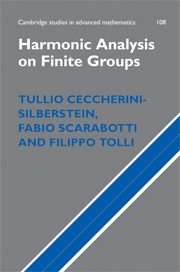Book contents
- Frontmatter
- Contents
- Preface
- Part I Preliminaries, examples and motivations
- Part II Representation theory and Gelfand pairs
- 3 Basic representation theory of finite groups
- 4 Finite Gelfand pairs
- 5 Distance regular graphs and the Hamming scheme
- 6 The Johnson scheme and the Bernoulli–Laplace diffusion model
- 7 The ultrametric space
- Part III Advanced theory
- Appendix 1 The discrete trigonometric transforms
- Appendix 2 Solutions of the exercises
- Bibliography
- Index
5 - Distance regular graphs and the Hamming scheme
from Part II - Representation theory and Gelfand pairs
Published online by Cambridge University Press: 28 December 2009
- Frontmatter
- Contents
- Preface
- Part I Preliminaries, examples and motivations
- Part II Representation theory and Gelfand pairs
- 3 Basic representation theory of finite groups
- 4 Finite Gelfand pairs
- 5 Distance regular graphs and the Hamming scheme
- 6 The Johnson scheme and the Bernoulli–Laplace diffusion model
- 7 The ultrametric space
- Part III Advanced theory
- Appendix 1 The discrete trigonometric transforms
- Appendix 2 Solutions of the exercises
- Bibliography
- Index
Summary
In this chapter we explore a theory which gives an alternative approach to some of the diffusion processes presented in the introduction (namely the random walk on the discrete circle, the Ehrenfest and the Bernoulli––Laplace models). In some sense, this can be regarded as a theory of (finite) Gelfand pairs without group theory. Thus, Sections 5.1, 5.2, and 5.3 (as well as Sections 6.1 and 6.3 in the next chapter) do not rely on group representation theory and can be read independently of Chapters 3 and 4. The connection with group theory will be presented in the final part of Section 5.4 and in Section 6.2.
Harmonic analysis on distance-regular graphs
In this section we focus our attention on a remarkable class of finite graphs for which it is possible to develop a nice harmonic analysis. Our exposition is inspired to the monographs by Bailey and by Bannai and Ito. We would like to mention that during our preparation of this book we attended a minicourse by Rosemary Bailey on association schemes which undoubtedly turned out to be very useful and stimulating for us.
We shall denote by X a finite, connected (undirected) graph without self-loops. Recall that given two vertices x, y ∈ X, their distance d(x, y) is the length of the shortest path joining x and y. This way, (X, d) becomes a metric space.
- Type
- Chapter
- Information
- Harmonic Analysis on Finite GroupsRepresentation Theory, Gelfand Pairs and Markov Chains, pp. 147 - 167Publisher: Cambridge University PressPrint publication year: 2008

